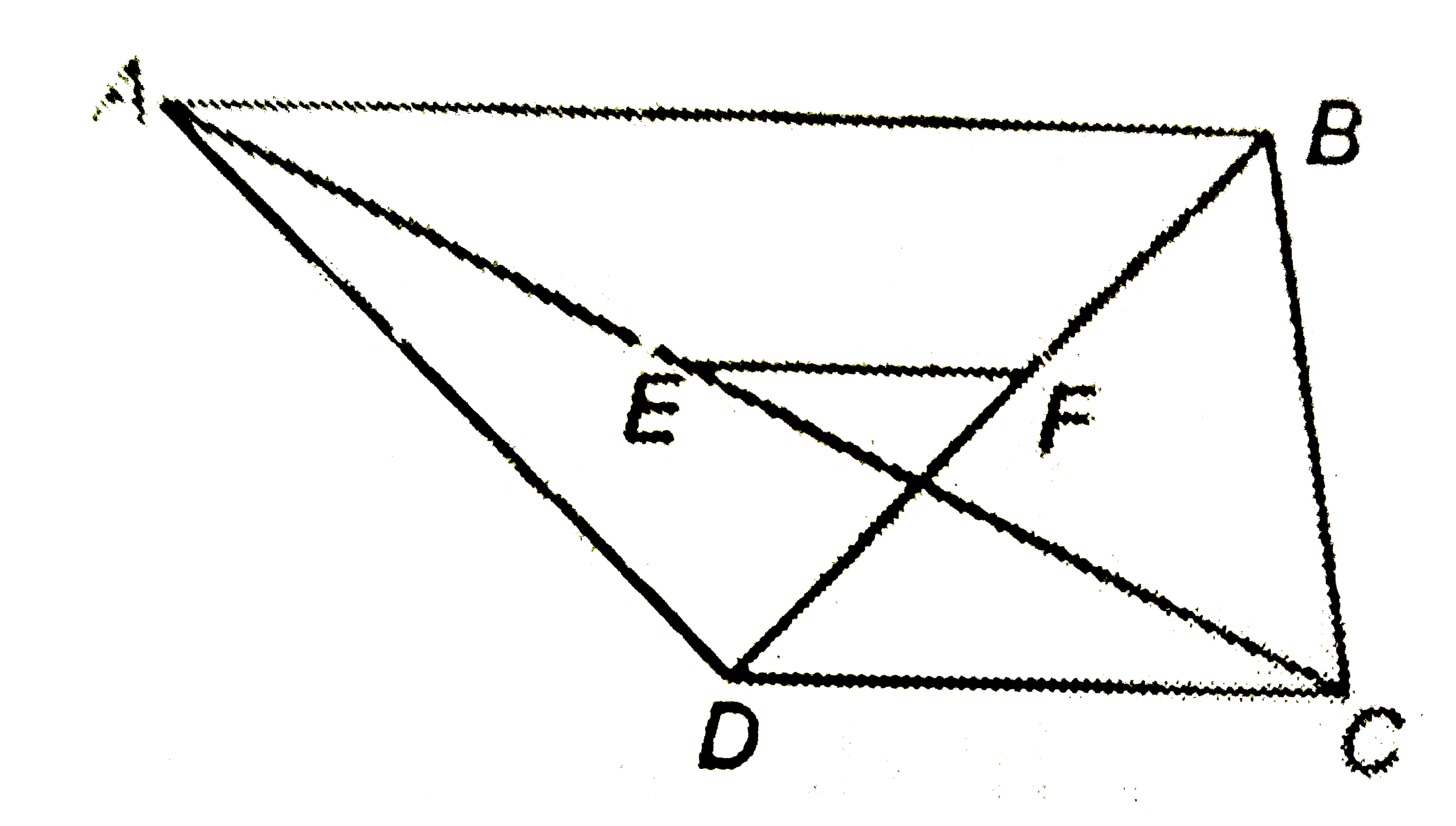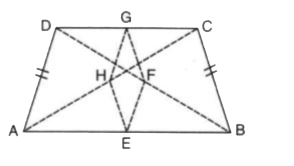In trapezium ABCD, AB is parallel to DC. P and Q are the mid-points of AD and BC respectively. BP product meets CD produced at point E. Prove that :
Point P bisects BE,
The correct Answer is:BP=PE
To prove that point P bisects BE in trapezium ABCD, where AB is parallel to DC, and P and Q are the midpoints of AD and BC respectively, we can follow these steps:
1. Draw the Trapezium:
- Draw trapezium ABCD with AB || DC.
- Mark points P and Q as the midpoints of sides AD and BC respectively.
2. Extend Line CD:
- Extend line CD to meet the line BP at point E.
3. Identify Angles:
- Since AB is parallel to DC, we know that angle ABP is equal to angle DPE (alternate interior angles).
- Similarly, angle APB is equal to angle PED (also alternate interior angles).
4. Triangles Involved:
- Consider triangles APB and DPE.
- We have:
- AP = PD (since P is the midpoint of AD)
- Angle APB = Angle DPE (as established above)
- Angle ABP = Angle PED (as established above)
5. Apply the ASA Criterion:
- Since we have two angles and the included side equal in both triangles, we can conclude that triangle APB is congruent to triangle DPE by the Angle-Side-Angle (ASA) criterion.
6. Corresponding Parts of Congruent Triangles:
- By the property of congruent triangles, we know that corresponding parts are equal.
- Therefore, PB = PE.
7. Conclusion:
- Since PB = PE, point P bisects line segment BE.
- Thus, we have proved that point P bisects BE.
- Draw trapezium ABCD with AB || DC.
- Mark points P and Q as the midpoints of sides AD and BC respectively.
- Extend line CD to meet the line BP at point E.
- Since AB is parallel to DC, we know that angle ABP is equal to angle DPE (alternate interior angles).
- Similarly, angle APB is equal to angle PED (also alternate interior angles).
- Consider triangles APB and DPE.
- We have:
- AP = PD (since P is the midpoint of AD)
- Angle APB = Angle DPE (as established above)
- Angle ABP = Angle PED (as established above)
- Since we have two angles and the included side equal in both triangles, we can conclude that triangle APB is congruent to triangle DPE by the Angle-Side-Angle (ASA) criterion.
- By the property of congruent triangles, we know that corresponding parts are equal.
- Therefore, PB = PE.
- Since PB = PE, point P bisects line segment BE.
- Thus, we have proved that point P bisects BE.
Topper's Solved these Questions
- MID-POINT THEOREMBOOK - ICSECHAPTER - MID-POINT THEOREMEXERCISE - 4 MARKS QUESTION
15 Videos
- MID-POINT AND ITS CONVERSE(INCLUDING INTERCEPT THEOREM)BOOK - ICSECHAPTER - MID-POINT AND ITS CONVERSE(INCLUDING INTERCEPT THEOREM)EXERCISE - EXERCISE 12(B)
23 Videos
- PYTHAGORAS THEORAMBOOK - ICSECHAPTER - PYTHAGORAS THEORAMEXERCISE - QUESTIONS
9 Videos
Similar Questions
In trapezium ABCD, AB is parallel to DC. P and Q are the mid-points of AD and BC respectively. BP produced meets CD produced at point E. Prove that :
PQ is parallel to AB.
View SolutionIn a trapezium ABCD, if E and F be the mid-points of diagonal AC and BD respectively. Prove that EF=12(AB−CD).

View SolutionIn a trapezium ABCD, side AB is parallel to side DC, and the diagonals AC and BD intersect each other at point P. Prove that :
ΔAPB is similar to ΔCPD.
View SolutionABCD is a square. P, Q and Rare the points on AB, BC and CD respectively, such that AP = BQ = CR. Prove that:
PQ = QR
View SolutionABCD is a square. P, Q and Rare the points on AB, BC and CD respectively, such that AP = BQ = CR. Prove that:
PB = QC
View SolutionP is a point on side BC of a parallelogram ABCD. If DP produced meets AB produced at point L, prove that :
DP:PL=DC:BL.
View SolutionP is a point on side BC of a parallelogram ABCD. If DP produced meets AB produced at point L, prove that :
DL:DP=AL:DC
View SolutionABCD is a quadrilateral in which AD = BC. E, F, G and H are the mid-points of AB, BD, CD and AC respectively. Prove that EFGH is a rhombus.

View SolutionABCD is a parallelogram. P and Q are the mid-points of sides AB and AD reapectively.
Prove that area of triangle APQ= 18 of the area of parallelogram ABCD.
View SolutionABCD is a parallelogram. P and Q are the mid-points of sides AB and AD reapectively.
Prove that area of triangle APQ= 18 of the area of parallelogram ABCD.
View Solution
